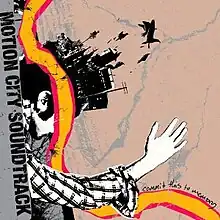| Commit This to Memory | ||||
|---|---|---|---|---|
 | ||||
| Studio album by | ||||
| Released | June 7, 2005 | |||
| Recorded | October–November 2004 Seedy Underbelly Studios (Valley Village, California) Sound Castle (Silver Lake, California) Cello Studios (Hollywood, California) | |||
| Genre | ||||
| Length | 39:19 | |||
| Label | Epitaph | |||
| Producer | Mark Hoppus | |||
| Motion City Soundtrack chronology | ||||
| ||||
| Singles from Commit This to Memory | ||||
| ||||
Commit This to Memory is the second studio album by American rock band Motion City Soundtrack. Produced by Mark Hoppus, the album was released on June 7, 2005, in the United States by Epitaph Records. The Minnesota-based rock act formed in 1997, developing their emotionally-charged, pop-punk sound over the interim years. Their debut LP, I Am the Movie, saw release on independent label Epitaph in 2003. It was followed with a heavy touring schedule, including stints on the Warped Tour and as the opening act for multi-platinum group Blink-182. Blink bassist Mark Hoppus took a liking to the quintet, offering to produce their next studio effort.
Recorded over six weeks in late 2004, Commit This to Memory was created largely at Seedy Underbelly Studios, a suburban home converted into a studio in Los Angeles' Valley Village region. The album was partially composed there and in their hometown of Minneapolis, during a period in which frontman Justin Pierre was seeking treatment for alcohol abuse. He aimed for stronger storytelling in his lyricism, inspired by the work of Tom Waits, Ben Folds, and John K. Samson. Hoppus mainly worked with the band on finalizing song arrangements.
Upon release, the album was viewed as the band's breakthrough,[2] with its gold-certified lead single "Everything Is Alright" adopted as their signature song. The album peaked at number two on Billboard's Independent Albums chart. The singles' music videos achieved rotation on cable channel MTV2 while the band toured alongside Fall Out Boy and Panic! at the Disco. In 2014, The A.V. Club referred to the album as a pop punk classic, "full of hook-laden, keyboard-assisted songs whose bright melodies don't mask the despair and self-loathing lurking beneath them."[3]
Background
Motion City Soundtrack was formed in Minneapolis, Minnesota. Vocalist Justin Pierre and guitarist Joshua Cain were friends who had come up playing in several local bands. Influenced by the synth-heavy rock of bands like the Rentals and Superchunk, the duo formed Motion City Soundtrack in 1997. It went through several lineup changes, with the band gaining permanent members Tony Thaxton (drums), Jesse Johnson (keys) and Matthew Taylor (bass) in 2001. The quintet recorded and self-released their debut album, I Am the Movie, in 2002, selling copies out of the back of their tour van for a year.[4] The next year, it was picked up for larger distribution through California-based independent label Epitaph, best known as the home of punk rockers the Offspring and Bad Religion. The group were part of an abundance of Epitaph signings, including Matchbook Romance and From First to Last, amid concerns the label had strayed too far from its roots, or "a little too emo."[5] The band toured heavily in support of the LP, attracting a new fanbase; their 2004 stint on the famed Vans Warped Tour was considered a "must-see" among punk fans.[5]
Their rise to prominence continued when the group joined Blink-182 - then one of the largest pop-punk acts worldwide - on a European arena tour. That band's bassist, Mark Hoppus, had first heard of the group from an employee at his clothing company, Atticus Clothing. He enjoyed the group so much that he raved about them in Rolling Stone magazine, and invited them to open for Blink. The six musicians became quick friends, frequently talking backstage before performances.[6][7] Hoppus was developing an interest in recording music from a production standpoint, having recently acquired a large amount of gear and amplifiers.[7] At the final show of the tour, Cain went to Hoppus' dressing room and asked him to produce their next record.[8] Although Hoppus had never produced anything before, he was excited to be a part of the album and accepted the offer.[7][9]
Recording and production

The band first began writing songs at their rehearsal space in Minneapolis, which they nicknamed the "Dungeon" due to its ability to "suck the life and energy out of the band."[4] For Pierre, the album came at the brink of a personal transition in which he began to seek treatment for alcohol abuse.[10] He left the band during the writing stages for Los Angeles where he moved in with Epitaph founder Brett Gurewitz and began attending Alcoholics Anonymous meetings.[2] Afterwards, the group rejoined Pierre in L.A. to begin recording demos for a month; the change of scenery brought about a new energy for the quintet.[4] Commit This to Memory would be the first album by the band to feature material crafted by each musician in the group, as previous releases had featured songs written in the years prior to each member joining.[4] "It was also the first time we had a lot more time and money to go in and feel like we were making a real record this time, whereas I Am the Movie was recorded in little segments here and there and eventually pieced together," said drummer Tony Thaxton.[11]
Recording sessions for Commit This to Memory were booked by Hoppus and scheduled over six weeks at Seedy Underbelly Studios in the L.A. suburb of Valley Village. The studio was actually a rented house that had once belonged to Jeff Porcaro, the drummer for Toto.[6][7][12] The band had, according to Hoppus, "a million ideas and a lot of energy and enthusiasm to make a great record".[7] Pierre strove for the record to have a sound that resembled the bands Braid, Superchunk, Jawbox and the Pixies.[12] Living in a suburb, the neighbors had called police to the band and Hoppus several times for being too loud at night time, especially when Hoppus brought a Roland TR-808 drum machine outside to work on a song late at night.[12] According to Pierre, Hoppus was not interested in putting his own stamp on the music, but rather bringing out the best in what he saw in the group.[10] Hoppus generally modeled his production after Jerry Finn (a longtime producer of Blink-182), and therefore it involved much watching and listening. "Mark kept telling us, 'Your name is going to be a lot bigger on the front than mine is on the back'," recalled Justin Pierre, "So he would throw suggestions out there but always say, 'Feel free to turn these down.' And we would!"[6]
Pierre characterized Hoppus as both "very involved and not involved", with his job as producer mainly giving notes on the sound of the instruments and offering suggestions to improve songs. Hoppus mostly worked with the band on arrangements, believing the songs were too packed and "needed to breathe".[7] Hoppus mentioned that label politics had hindered the creativity of Blink's Take Off Your Pants and Jacket (2001), and did not want to see the same fate befall the band.[13] He was "meticulous" in his approach, partially due to the fact that it was his first production job. Hoppus was the one who advised the band to merge two previously unrelated songs—a slower, softer song and a pulsating drum track—into one, which became "Time Turned Fragile".[10] The frontman of Fall Out Boy, Patrick Stump, contributed guest vocals to "Everything Is Alright", and Hoppus to "Hangman".[14] With production completed, Hoppus was very excited for the band that he felt was on the cusp of "great things", recalling, "After six weeks of these guys living all together in two rooms of this house with a studio attached they created this amazingly beautiful and honest album. Justin's lyrics are so brutally truthful."[7] The group completed recording in November 2004, and judged final mixes over the interim months.[5] Pierre later called Commit This to Memory his personal favorite album by the band.[15]
Music


In a 2015 interview, Pierre notes that fans have told him that they find Commit This to Memory a "winter album", to which he agrees, noting the unintentional mention of the new year in several songs.[10] His lyricism on Commit This to Memory centralizes around change and, in his words, "being a complete fuckup, yet, at the same time, being somewhat successful".[16] On the record, he "addresses the themes of substance abuse, psychological disorders and failing relationships."[17] Pierre penned "Everything Is Alright" as a summary of his OCD (Obsessive–compulsive disorder) tendencies. He intended to utilize his social anxiety and fears in the song's form, which he has since employed in numerous other compositions. "I don't think the [phrase] "tongue-in-cheek" is correct, but it's something where the verses are one thing and then the chorus is another, but it's sort of like giving yourself a pep talk", said Pierre.[18] The song's lyrics include hating such mundane things as "theme parks, flying, strangers, [and] waiting in line," things that Pierre genuinely disliked at the time of the song's writing.[18] For the record, he intended to simplify his lyrics to enhance storytelling and he drew inspiration from Tom Waits, Ben Folds and John K. Samson's writing styles.[16] Keeping in the Waits/Folds inspiration, Pierre strove to write from another person's point of view; in the case of "Time Turned Fragile", it is sung from the perspective of his father.[9]
Pierre has in retrospect labeled half of the album's writing as being completed while inebriated and the other half while getting sober.[15] For example, he penned the lyrics to "Attractive Today" and "Time Turned Fragile" while drunk in his apartment, in a "sad and lonely place".[10] In this approach, words mostly "just came out", and were not substantially revised. In addition, he was listening to the 2003 album Reconstruction Site by the Weakerthans, and found himself inspired by the songwriting of frontman John K. Samson.[10] Pierre would often take lyrics from other bands songs for song titles; "Time Turned Fragile" is lifted from a lyric in Limbeck's "Julia", while "Together We'll Ring in the New Year" was pulled from the Tom Waits song "Please Wake Me Up".[10] "L.G. Fuad"—which stands for "Let's Get Fucked Up and Die"—grew out of a night on Motion City Soundtrack's 2003 UK tour with The All-American Rejects, in which the latter band's merchandise manager was severely inebriated.[16] He stood on the merchandise stand and shouted what became the song's refrain. All involved found great humor in the "mantra", which went on to be printed on business cards as a joke.[16] "Hold Me Down" was inspired by a former roommate of Pierre's. After she had moved out, Pierre found a portion of her math homework in a couch cushion, leading to him imagining a scenario of finding a letter from a departed lover.[10]
The album has been called definitive of pop punk.[3] Joshua Cain dismissed this label, remarking, "I definitely wouldn't consider us a pop-punk band. Our influences are more based on '90s bands like Superchunk and early Weezer."[19]
Reception
| Review scores | |
|---|---|
| Source | Rating |
| AbsolutePunk | (Favorable)[20] |
| Allmusic | |
| Alternative Press | |
| Entertainment Weekly | (mixed)[22] |
| PopMatters | (5/10)[23] |
Upon its release, Commit This to Memory received general acclaim from music critics. Scott Heisel of Alternative Press wrote that "Memory is an inspired, mature sophomore disc chock full of catchy, intelligent pop-rock."[24] Allmusic's Johnny Loftus considered the band more intelligent and sophisticated than their Warped Tour peers: "Motion City Soundtrack['s] wistful memories, tales of breaking up, and frantic searches for answers [are] realer than the next pop-punk combo on the quadruple summertime bill."[25] Jennifer Maerz of Entertainment Weekly ended her review with the note that "MCS' slick, soaring anthems ultimately unite the spirits of those who see themselves, like Pierre, as 'lifeless corners of this empty frame.'"[22] Mark Griffiths of Kerrang! wrote, "It's a bright and invigorating affair [...] and is, in short, fantastic."[26] The Washington Post's Marianne Meyer opined that the record "nimbly moves from skittish rhythms to genuinely tender sentiment."[27]
Jessica Grose of Spin favorably compared it to Blink-182's Enema of the State (1999).[28] Tony McMenamin of Blender deemed it the publication's album of the month, calling it "a charged mix of instantly catchy pop-punk lashings and somber acoustic wailings."[29]
The album was leaked to file sharing websites within a day of the final mastering and months before its official release.[30] It debuted on the Billboard 200 in the issue dated June 25, 2005 at position 72,[31] selling 16,000 copies in its opening week.[32] It charted better on the magazine's Independent Albums chart, where it peaked at number two.[33] The last official estimate placed it at 285,000 albums sold in the U.S.,[34] but Pierre said in 2015 interview that the number is closer to 500,000.[15] The band's music videos found regular rotation on networks such as MTV2, and the band also performed on Late Night with Conan O'Brien.[35] Rolling Stone's Lauren Gilton considered the album a sleeper hit.[36] Nevertheless, the band's breakthrough brought naysayers, and the group became targets for critics of pop punk: "[the band was] frequently characterized as the sort of ultra-commercial punk poseurs who water down the genre to the point of drowning it."[35]
Subsequent reviews of the album have continued to be positive. In 2014, The A.V. Club referred to the album as a classic of pop punk, "full of hook-laden, keyboard-assisted songs whose bright melodies don't mask the despair and self-loathing lurking beneath them."[3] Reyan Ali of Cincinnati CityBeat wrote that Commit This to Memory "absolutely bleeds charm", commenting, "Even with all the dire thematic matter Pierre's lyrics covered, [...] the band framed the words with music that sparkled, owing to spunky, inspired hooks, full-sounding record production and ample doses of Moog."[2] Alternative Press's Tyler Sharp deemed the record a "classic",[37] while Taylor Morgan of OC Weekly called it "the soundtrack of millennial youth, reminiscent of breakups, making out, goofing off, and growing up."[34] BuzzFeed included the album at number 21 on their "36 Pop Punk Albums You Need To Hear Before You F——ing Die" list.[38] NME listed the album as one of "20 Pop Punk Albums Which Will Make You Nostalgic".[39]
Touring

During the recording of the album, the band embarked on their first headlining tour, The Sub-Par Punk Who Cares Tour 2004.[5] After recording, the band set out on the inaugural Epitaph Tour, alongside Matchbook Romance and From First to Last, with appearances by the Matches and Scatter the Ashes on select dates.[40] The tour visited every major US city, and ran from February 2 to March 19, 2005.[40] The band played to larger crowds on the tours supporting the album, including over 9,000 fans on a Chicago date in 2005.[4] The group "toured incessantly", including dates on the Warped Tour 2005.[11] Afterwards, the band joined the Nintendo Fusion Tour with Fall Out Boy, Panic! at the Disco, and The Starting Line, which was their largest nationwide tour to that point.[4] The group had been friends with Fall Out Boy for many years prior, having both played side-by-side before either group found their respective success.[11]
The band embarked on a tour celebrating the tenth anniversary of the album between January and February 2015, playing the album in its entirety.[37] "It doesn't feel like ten years ago, but then it also feels like a lifetime ago," said Pierre.[17] The group later extended this anniversary tour, and further toured the album between June and August 2015.[41]
Track listing
All tracks are written by Motion City Soundtrack
| No. | Title | Length |
|---|---|---|
| 1. | "Attractive Today" | 1:42 |
| 2. | "Everything Is Alright" | 3:26 |
| 3. | "When "You're" Around" | 2:51 |
| 4. | "Resolution" | 3:48 |
| 5. | "Feel Like Rain" | 3:34 |
| 6. | "Make Out Kids" | 3:04 |
| 7. | "Time Turned Fragile" | 4:15 |
| 8. | "L.G. Fuad" | 3:06 |
| 9. | "Better Open the Door" | 3:00 |
| 10. | "Together We'll Ring in the New Year" | 2:13 |
| 11. | "Hangman" | 2:51 |
| 12. | "Hold Me Down" | 5:19 |
| No. | Title | Length |
|---|---|---|
| 13. | "Invisible Monsters" | 3:55 |
Personnel
Credits adapted from the album's liner notes.[14]
|
Band
Additional musicians
|
Production
Design
|
Charts
Weekly charts
|
Year-end charts
|
References
- ↑ Bacle, Ariana (March 11, 2016). "Motion City Soundtrack Announce Break Up". Entertainment Weekly. Archived from the original on March 11, 2016. Retrieved March 11, 2016.
- 1 2 3 Reyan Ali (January 14, 2015). "Reeling in the Years". Cincinnati CityBeat. Cincinnati, Ohio. Retrieved May 29, 2015.
- 1 2 3 4 Kyle Ryan; Jason Heller; David Anthony (March 6, 2014). "A beginner's guide to the bouncy buzz of pop-punk". The A.V. Club. Retrieved May 27, 2020.
- 1 2 3 4 5 6 "Forward Motion". The Age. August 26, 2005. Retrieved April 15, 2014.
- 1 2 3 4 Chris Rager (December 20, 2004). "Cain is Able : Motion City Soundtrack's Joshua Cain is all business". Cleveland Free Times.
- 1 2 3 Shooman, Joe (June 24, 2010). Blink-182: The Bands, The Breakdown & The Return. Independent Music Press. p. 147. ISBN 978-1-90619-110-8.
- 1 2 3 4 5 6 7 "Mark Hoppus Interview". pickRset. September 3, 2008. Archived from the original on February 11, 2009. Retrieved November 4, 2012.
- ↑ James Montgomery (July 31, 2009). "Motion City Soundtrack Tell Blink-182's Mark Hoppus How Great He Is". MTV News. Retrieved November 4, 2012.
- 1 2 Robertson, Jessica (June 9, 2005). "Motion City Get Committed". Rolling Stone (976). ISSN 0035-791X.
- 1 2 3 4 5 6 7 8 Lucy, Evan (Interviewer); Pierre, Justin (Interviewee) (January 15, 2015). Episode 025: Justin Pierre (10-Year Motion City Soundtrack Retrospective) (Podcast). Voice & Verse. Archived from the original (mp3) on January 15, 2015. Retrieved January 15, 2015.
- 1 2 3 Michael Petitti (October 27, 2005). "Motion City Soundtrack keeps busy". Arizona Daily Wildcat. Retrieved April 15, 2014.
- 1 2 3 James Montgomery (June 16, 2005). "Mark Hoppus Throws House Party For Motion City Soundtrack". MTV News. Retrieved November 4, 2012.
- ↑ Keith Carman (April 27, 2005). "Motion City Soundtrack Give Mad Props To Blink's Hoppus". ChartAttack.
- 1 2 Commit This to Memory (liner notes). Motion City Soundtrack. US: Epitaph. 2005. 86750-2.
{{cite AV media notes}}: CS1 maint: others in cite AV media (notes) (link) - 1 2 3 Jonah Bayer (October 1, 2015). "Rank Your Records: Motion City Soundtrack's Justin Pierre Rates the Band's Five Albums". Noisey (Vice Media, Inc.). Retrieved October 1, 2015.
- 1 2 3 4 "Motion City Soundtrack Article". Alternative Press (204): 129–130. July 2005. ISSN 1065-1667.
- 1 2 Justin Franco (January 12, 2015). "Interview with Motion City Soundtrack; Vocalist and Guitarist Justin Pierre Discusses 'Commit This To Memory', Songwriting and the Shortest Lifetime Ever". Pure Grain Audio. Archived from the original on February 6, 2015. Retrieved January 15, 2015.
- 1 2 Jason Pettigrew (July 29, 2013). "BackTracking: The story of "Everything Is Alright" by Motion City Soundtrack". Alternative Press. Archived from the original on August 1, 2013. Retrieved April 15, 2014.
- ↑ Eric Schelkopf (January 28, 2005). "Epitaph bands join for tour stops at NIU, Metro". Kane County Chronicle. Archived from the original on March 12, 2005.
- ↑ Kohli, Rohan. "Motion City Soundtrack – Commit This To Memory". AbsolutePunk. Retrieved November 28, 2009.
- ↑ Loftus, Johnny. "Commit This to Memory > Overview". AllMusic. Retrieved November 28, 2009.
- 1 2 Maerz, Jennifer (June 13, 2005). "Commit This to Memory – Review". Entertainment Weekly. No. 825. ISSN 1049-0434. Retrieved September 27, 2012.
- ↑ Jagernauth, Kevin. "Motion City Soundtrack: Commit This to Memory". PopMatters. Retrieved November 28, 2009.
- ↑ Scott Heisel. "Review: Commit This to Memory". Alternative Press. Retrieved April 14, 2014.
- ↑ Johnny Loftus. "Review: Commit This to Memory". AllMusic. Retrieved April 14, 2014.
- ↑ Mark Griffiths (July 2005). "Album Reviews". Kerrang!. Archived from the original on September 26, 2006. Retrieved May 29, 2015.
- ↑ Marianne Meyer (April 27, 2005). "Live!". The Washington Post. Retrieved May 29, 2015.
- ↑ Jessica Grose (June 9, 2005). "Band of the Day: Motion City Soundtrack". Spin. Archived from the original on August 9, 2006. Retrieved May 29, 2015.
- ↑ Tony McMenamin (July 2005). "Editors' Picks: July 2005". Blender. Archived from the original on November 23, 2005. Retrieved May 29, 2015.
- ↑ Megan Cunningham, Mike Raffensperger (Producers). Rehearsal Space: Motion City Soundtrack (Interview). Zoom-In. Archived from the original (Streaming video) on July 5, 2008. Retrieved May 29, 2015.
- ↑ "The Billboard 200". Billboard. Vol. 117, no. 26. June 25, 2005. p. 53. ISSN 0006-2510.
- ↑ Cortney Harding (October 6, 2007). "Chart Motion". Billboard. Vol. 119, no. 40. p. 46. ISSN 0006-2510.
- 1 2 "Motion City Soundtrack Chart History (Independent Albums)". Billboard. Retrieved May 29, 2015.
- 1 2 Taylor Morgan (February 13, 2015). "Motion City Soundtrack Delivers Pop Punk Nostalgia in Anaheim". OC Weekly. Archived from the original on May 18, 2015. Retrieved May 29, 2015.
- 1 2 Michael Roberts (February 16, 2006). "Constant Motion". Westword. Retrieved April 15, 2014.
- ↑ Lauren Gilton (December 1, 2005). "Bands to Watch: Motion City Soundtrack". No. 988. p. 28. Archived from the original on December 18, 2006. Retrieved May 29, 2015.
- 1 2 Tyler Sharp (November 10, 2014). "Motion City Soundtrack announce 'Commit This To Memory' 10th Anniversary Tour". Alternative Press. Retrieved May 29, 2015.
- ↑ Sherman, Maria; Broderick, Ryan (July 2, 2013). "36 Pop Punk Albums You Need To Hear Before You F----ing Die". BuzzFeed. Retrieved July 29, 2015.
- ↑ "20 Pop Punk Albums Which Will Make You Nostalgic". NME. June 9, 2014. Retrieved July 29, 2015.
- 1 2 Barry A. Jeckell (November 19, 2004). "Billboard Bits: KROQ, Epitaph, American Hi-Fi". Billboard. Retrieved April 20, 2014.
- ↑ Sarah Marie Pittman (April 30, 2015). "Motion City Soundtrack's 10-Year Anniversary Party". Pollstar. Archived from the original on April 22, 2016. Retrieved May 29, 2015.
- ↑ "Motion City Soundtrack Chart History (Billboard 200)". Billboard. Retrieved May 29, 2015.
- ↑ "Motion City Soundtrack Chart History (Independent Albums)". Billboard. Retrieved May 29, 2015.
External links
- Commit This to Memory (deluxe edition) at YouTube (streamed copy where licensed)
- Official website
- 2007 television commercial promoting the album